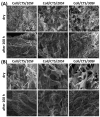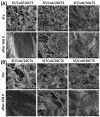Biomaterials with Potential Use in Bone Tissue Regeneration-Collagen/Chitosan/Silk Fibroin Scaffolds Cross-Linked by EDC/NHS
- PMID: 33652959
- PMCID: PMC7956200
- DOI: 10.3390/ma14051105
Biomaterials with Potential Use in Bone Tissue Regeneration-Collagen/Chitosan/Silk Fibroin Scaffolds Cross-Linked by EDC/NHS
Abstract
Blending of different biopolymers, e.g., collagen, chitosan, silk fibroin and cross-linking modifications of these mixtures can lead to new materials with improved physico-chemical properties, compared to single-component scaffolds. Three-dimensional scaffolds based on three-component mixtures of silk fibroin, collagen and chitosan, chemically cross-linked, were prepared and their physico-chemical and biological properties were evaluated. A mixture of EDC (N-(3-dimethylaminopropyl)-N'-ethylcarbodiimide hydrochloride) and NHS (N-hydroxysuccinimide) was used as a cross-linking agent. FTIR was used to observe the position of the peaks characteristic for collagen, chitosan and silk fibroin. The following properties depending on the scaffold structure were studied: swelling behavior, liquid uptake, moisture content, porosity, density, and mechanical parameters. Scanning Electron Microscopy imaging was performed. Additionally, the biological properties of these materials were assessed, by metabolic activity assay. The results showed that the three-component mixtures, cross-linked by EDC/NHS and prepared by lyophilization method, presented porous structures. They were characterized by a high swelling degree. The composition of scaffolds has an influence on mechanical properties. All of the studied materials were cytocompatible with MG-63 osteoblast-like cells.
Keywords: EDC/NHS; chitosan; collagen; silk fibroin; three-dimensional scaffolds.
Conflict of interest statement
The authors declare no conflict of interest.
Figures













References
-
- Sionkowska A. Current Research on the Blends of Natural and Synthetic Polymers as New Biomaterials: Review. Prog. Polym. Sci. 2011;36:1254–1276. doi: 10.1016/j.progpolymsci.2011.05.003. - DOI
-
- Cicciù M., Cervino G., Herford A.S., Famà F., Bramanti E., Fiorillo L., Lauritano F., Sambataro S., Troiano G., Laino L. Facial Bone Reconstruction Using Both Marine or Non-Marine Bone Substitutes: Evaluation of Current Outcomes in a Systematic Literature Review. Mar. Drugs. 2018;16 doi: 10.3390/md16010027. - DOI - PMC - PubMed
Grants and funding
LinkOut - more resources
Full Text Sources
Other Literature Sources

